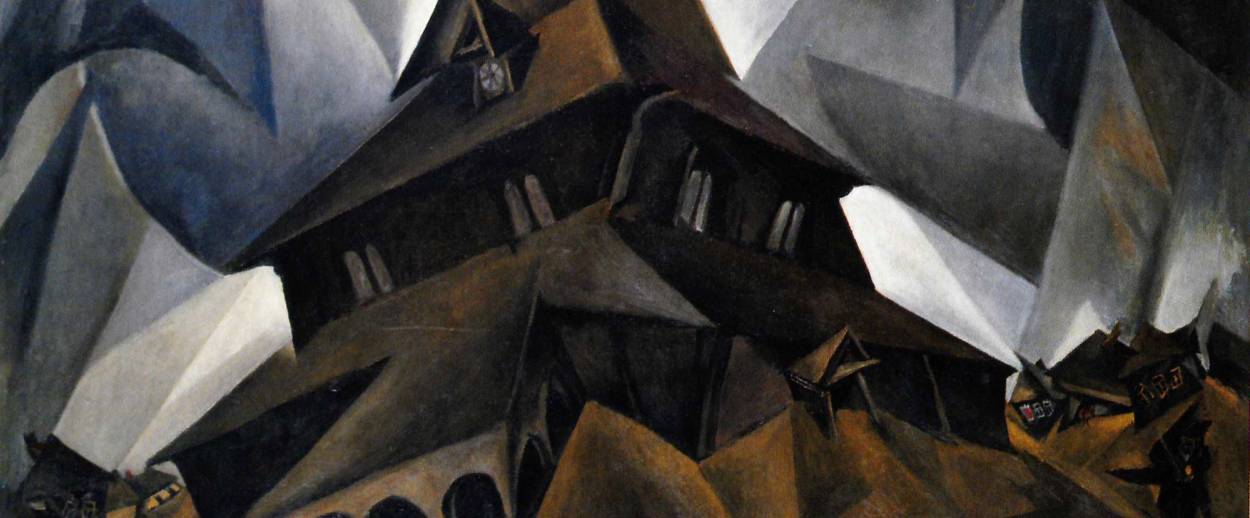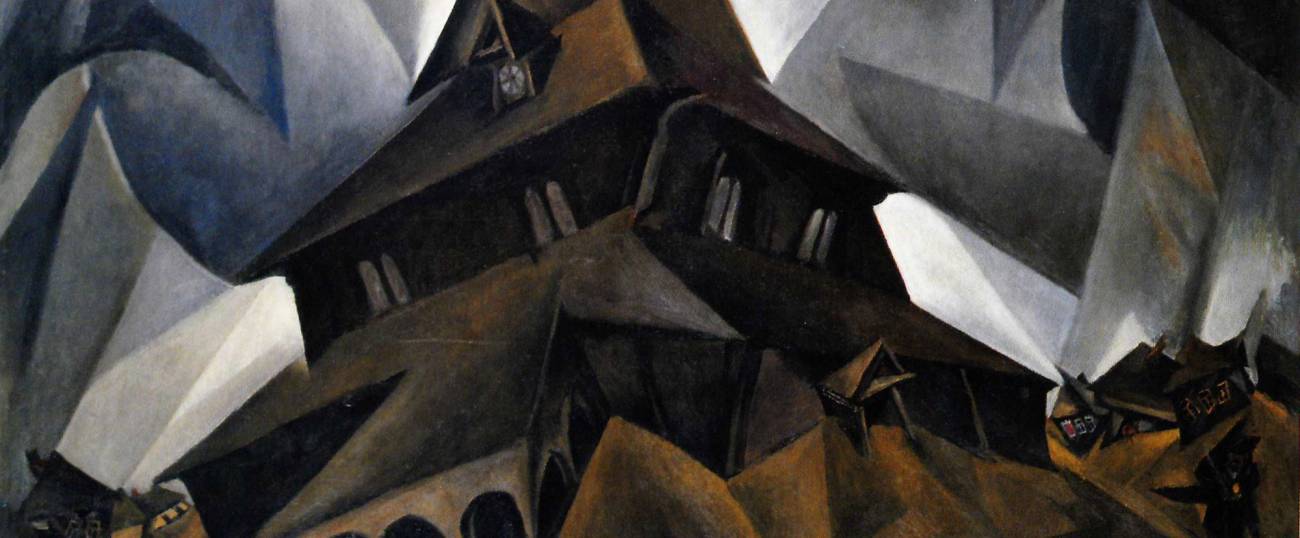The Cross on Our Foreheads
The best Yiddish story ever written about a pogrom is by Lamed Shapiro, the early 20th-century American Yiddish writer who wanted the Jews to get woke





Even if you’ve never read a pogrom story before, you probably know how one should go. The pogromists burst through the door, smash some furniture, and then rape and murder some Jews, whose job is to whimper and die. Lamed Shapiro’s “The Cross,” the very best Yiddish story ever written about a pogrom (and possibly the best Yiddish story ever written, period) goes exactly like that—except that the guy who survives the attack then goes out and rapes and murders his non-Jewish love interest. If you’re thinking, “Wait, THAT wasn’t supposed to happen! That is totally sick!” then you, dear reader, are part of the problem.
Lamed (short for Levi Yehoshua) Shapiro was an American Yiddish writer whose life was a cascade of failures. Born in 1878 outside of Kiev, he moved to Warsaw at 18 to become a writer. At 20 he admitted failure and returned home, arriving just in time for a brutal pogrom. On returning to Warsaw he had his first and only brush with success: His work was blessed by Yiddish literary kingmaker Y.L. Peretz, who published Shapiro’s first stories in his prestigious magazine. But literature rarely feeds people, and in 1906 Shapiro immigrated to New York. After three years he moved to Chicago and opened a restaurant, which failed. He then left for Switzerland, moved to Warsaw, returned to Switzerland, went back to New York, opened another restaurant, which failed, left for Los Angeles, returned to New York, then went to Cleveland to open another restaurant, which failed. In 1921, he returned to Los Angeles with a brilliant idea: making movies in color. He experimented with color cinematography for 10 years, and (wait for it) failed. He became a Communist, became an alcoholic, and died in 1948. Along the way he also became one of the greatest Yiddish prose writers of the 20th century, publishing stories about alienation in America and violence in Europe—including, in 1909, his heart-stopping story “The Cross.”
“The Cross” begins in a wide-open America, where Yiddish-speaking hoboes ride freight trains across the prairie. One hobo’s forehead is branded with a scar shaped like a cross. When another hobo asks him where it came from, he hears the story that has paralyzed every reader since.
Our hero (who remains unnamed) was once a medical student in Russia, living with his mother, active in a revolutionary cell, and in love with a non-Jewish fellow revolutionary. To impress her, our hero grandly volunteers for a dangerous mission. But his plans to make history and wow his crush go south when thugs burst into his apartment, beat him to a pulp, tie him to the foot of his mother’s bed, and then gang-rape his mother while he watches before shredding her breasts, gouging out one of her eyes and bludgeoning her nearly unconscious. They carve a cross into his forehead before leaving them both to bleed to death.
Working his way out of his bonds over several hours, our hero mercy-kills his mother before proceeding into the city, where the pogrom is still in full swing. He doesn’t see any of his fellow revolutionaries who promised to defend the Jews, though. He does, however, see plenty of arson, looting, and murder, including a young man splitting open an old man’s head with an ax. He also sees a young Jewish man with a revolver who succeeds in cornering the head-splitter—and then shoots himself in the head. Several days into the melee, our hero stops by his crush’s house. At her request, he tells her everything. She cries (“real tears, I swear!”), but then asks him if he will still complete his revolutionary mission. Instead of replying, he rapes and murders her.
“The Cross” (available in English translation) might remind readers of Richard Wright’s 1940 novel Native Son, about a young black man who accidentally kills his white employer’s daughter and then intentionally rapes and murders his own girlfriend. That book forced white readers to acknowledge systemic racism: The book’s black characters live in soul-destroying poverty, and the protagonist has zero education or even self-awareness. It also forced white readers to confront their distaste for a black character who isn’t an Uncle Tom. (The protagonist is named “Bigger Thomas.”)
Shapiro, writing in Yiddish, did not expect non-Jews to read his work. His goal wasn’t to change anti-Semitism. His goal was to change the Jews.
Wright was accused by black critics, notably James Baldwin, of pamphleteering for white readers. But Shapiro, writing in Yiddish, did not expect non-Jews to read his work. His goal wasn’t to change anti-Semitism. His goal was to change the Jews.
Unlike Bigger Thomas, Shapiro’s protagonist is profoundly self-aware and recognizes the inviolable link between power and dignity. He hates his mother, who abused him for years. When he was 12, he hit her back; after that, she never beat him again. He says that his father, long dead, was “something”—suggesting an impressive person, though all we’re told of him is that he “didn’t belong in this world; he was too ‘hotheaded.’ ” These hints become keys to the protagonist’s actions. Fighting his attackers before being overpowered, he describes how “a fierce heat took over my entire body. … I was strangely enjoying myself.” Shapiro’s language is mostly understated, but in the protagonist’s delirium, Shapiro has him imagine a revised biblical commandment: “I am a zealous and vengeful God, and I demand of you: Be something!” The story’s power turns on the “something” the protagonist becomes.
What is most astounding about “The Cross” is how starkly it reveals a deep sickness in the reader’s mind. The story is obviously a disturbing one. But as troubled as the reader might be by the mother’s gruesome rape and murder, the reader is not shocked by it; the scene inspires disgust and despair, but not horror. We only become truly horrified when the protagonist attacks his love interest. Then we are shocked and righteously appalled. The story’s question is why.
In teaching Shapiro’s story, I have been amazed by how consistent my students’ responses are. They invariably fume at the protagonist’s outrageous crimes. When I point out that none of them expressed outrage at the mother’s rape and murder (which is far more vividly described), they spout platitudes about higher moral standards and two wrongs not making a right. Only gradually do they recognize what their “higher moral standards” amount to: an unexamined belief that Jews are supposed to be raped and murdered, and that one of the wrongs is, actually, right. They unconsciously see the pogrom as natural, as attacks against Jews are still often seen today.
Murdering cartoonists in a magazine office is a civilizational threat. Murdering Jews in a supermarket is sad, but not a threat to our civilization… perhaps because, in some unconscious and horrific way, it is our civilization. “The Cross” doesn’t merely reveal this truth. It reveals how we are complicit in it.
“The Cross” ends with the narrator’s dark reflection: “There will rise up a generation of iron men. And they will rebuild that which we have allowed to be destroyed.” Today this sounds like Zionism. But Shapiro was an American, and the protagonist’s healing comes from the American promise of erasing the past. He leaves for America immediately, and after wandering for three years, “I, newborn child, feel that I am strong enough. Soon I’ll return to civilization. And then—”
Those are the protagonist’s last words. In our new and alarming America, we are living in that “and then.” Reading this story today, it is haunting to consider the Jewish community’s current hopes and fears—and to realize that we still bear the scars of the past on our foreheads.
***
Read Dara Horn’s reviews of forgotten Yiddish and Hebrew literature here.
Dara Horn is the award-winning author of five novels and the essay collection People Love Dead Jews.